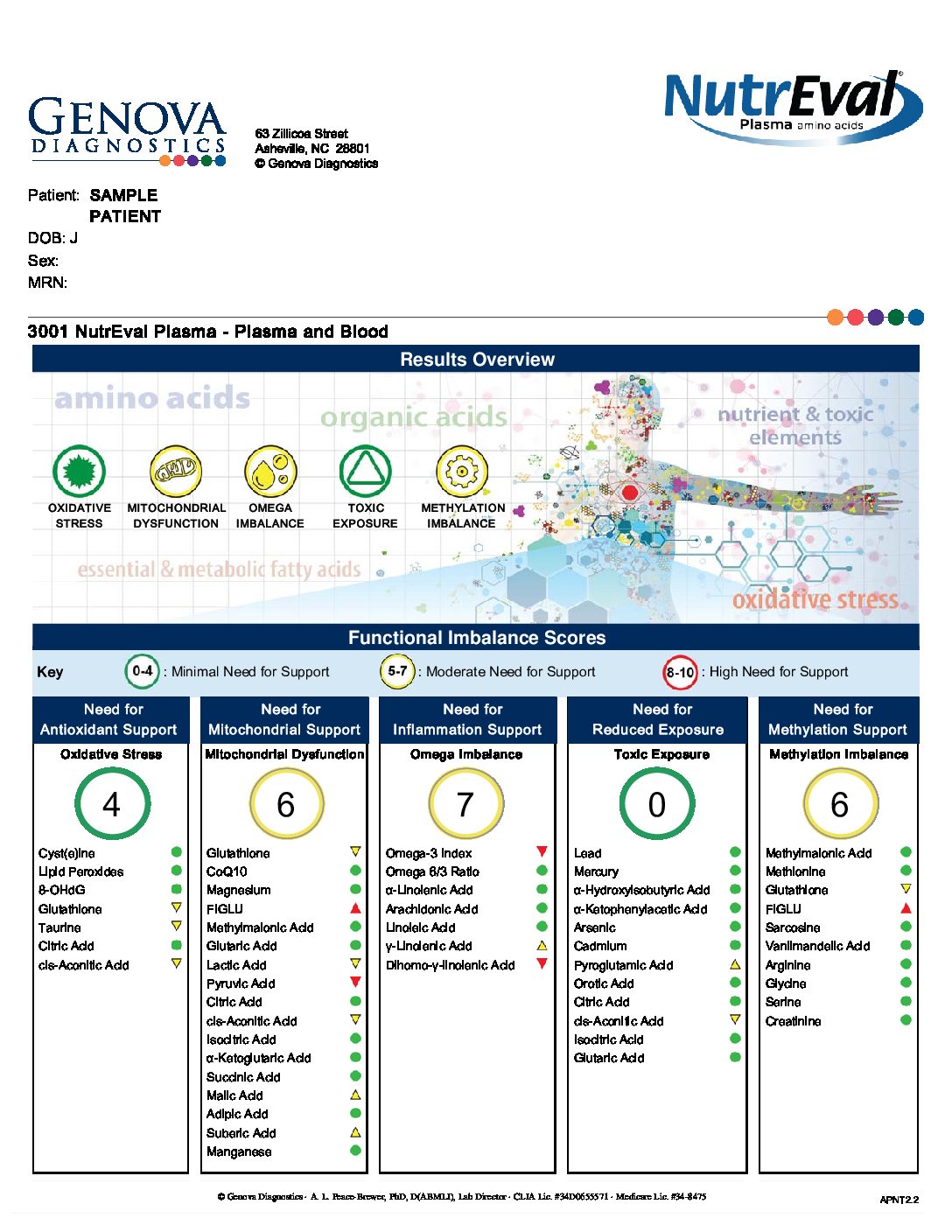Description
Test Specimen: Plasma
Symptoms and conditions associated with nutrient imbalances
- Mood disorders
- Cardiovascular disease
- Obesity/ Insulin resistance/ Type 2 Diabetes
- Fatigue
- Weight Issues / Dietary Guidance
- Malnutrition often observed in the elderly
- Maldigestion/Malabsorption
- Increased nutrient demand in athletes
- Increased nutrient demand in physical trauma/healing
Test Analytes:
The biomarkers on the NutrEval are arranged as follows (see sample report for individual analytes):
- Metabolic Analysis Markers (urine organic acids)
- Malabsorption and Bacterial/ Yeast Dysbiosis Markers are metabolites produced by the gastrointestinal microbiome
- Cellular Energy & Mitochondrial Metabolites are biomarkers of carbohydrate and fatty acid metabolism, and the citric acid (Kreb’s) cycle
- Neurotransmitter Metabolites are downstream byproducts of epinephrine, norepinephrine, serotonin and dopamine
- Vitamin Marker are specific analytes used to assess functional levels of vitamin cofactors
- Toxin & Detoxification Markers relate to certain toxic metabolites and the body’s detoxification capacity
- Amino Acids (plasma)
- Essential Amino Acids must be derived from dietary sources
- Nonessential Amino Acids are synthesized by the body
- Intermediary Metabolites are byproducts of amino acid metabolism
- B Vitamin Markers are involved in biochemical reactions that specifically require B vitamins
- Urea Cycle Markers are byproducts associated with nitrogen detoxification
- Glycine/Serine Metabolites are involved in the serine-to-choline pathway and the methylation pathways
- Dietary Peptide Related Markers can indicate incomplete protein breakdown
- Essential and Metabolic Fatty Acids Markers (RBCs)
- Omega 3 Fatty Acids are essential for brain function and cardiovascular health and are anti-inflammatory
- Omega 6 Fatty Acids are involved in the balance of inflammation
- Omega 9 Fatty Acids are important for brain growth, nerve cell myelin, and reducing inflammation
- Saturated Fatty Acids are involved in liproprotein metabolism and adipose tissue inflammation
- Monounsaturated Fats include omega 7 fats and unhealthy trans fats
- Delta-6 Desaturase Activity assesses efficiency of this enzyme to metabolize omega 6’s and omega 3’s
- Cardiovascular Risk includes specific ratios and the Omega 3 Index
- Oxidative Stress Markers include antioxidants glutathione (whole blood) and Coenzyme Q10 (serum), as well as the oxidative damage markers lipid peroxides and 8-OHdG (urine)
- Elemental Markers
- Nutrient Elements are direct measurements of copper and zinc (plasma), magnesium and potassium (RBC), and manganese and selenium (whole blood)
- Toxic Elements (whole blood) indicate exposure to lead, mercury, arsenic, cadmium or tin within approximately a 90-120 day timeframe
A Functional Nutritional Assessment
There are various methods of assessing nutrient status, including intracellular and extracellular direct measurement, and measuring biochemical pathway markers that require specific nutrient cofactors for proper metabolism. The NutrEval uses a combination of these methods and synthesizes the information via an algorithm that determines personalized nutrient needs. The algorithm is based on functional markers shown in the literature to be associated with a need for a particular nutrient.
Functional evaluation of nutritional status assesses metabolic intermediates produced in enzymatic pathways of cellular energy production, detoxification, neurotransmitter breakdown, and amino acid metabolism. Specific metabolites outside of reference range may signal a metabolic inhibition or block. This abnormality may be due to a nutrient deficiency, an inherited enzyme deficit, toxic build-up, or drug effect. It is possible for an individual to have normal blood levels of a vitamin in order to maintain homeostasis, while exhibiting signs of insufficiency/deficiency for that vitamin. For this reason, direct testing of individual nutrients alone does not provide a complete picture.
Other methods of assessing nutrient status, such as intracellular lymphocyte testing, has limited literature support.
Conventional nutritional panels include tests such as complete blood count, comprehensive metabolic panel, iron, ferritin and other select nutrients. The NutrEval is not meant to be a substitute for this important testing, but rather a complement by providing additional information.
What can you expect from NutrEval Plasma testing?
Personalized recommendations for amino acids, fatty acids, vitamins, minerals, digestive support, and other nutrients are provided for each patient. Additionally, exposure to select toxic substances and oxidative stressors may need to be addressed. Comprehensive stool testing or SIBO breath testing may be appropriate to investigate the possible cause for maldigestion/malabsorption and dysbiosis.



